New insights into the plumbing system of Santorini using helium and carbon isotopes
Affiliations | Corresponding Author | Cite as | Funding information- Share this article





Article views:2,796Cumulative count of HTML views and PDF downloads.
- Download Citation
- Rights & Permissions
top
Abstract
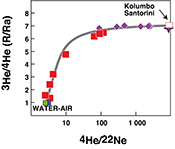
Figures and Tables
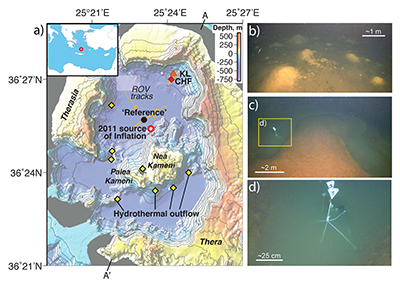 Figure 1 (a) Synthetic topographic map (Nomikou et al., 2014) showing the position of hydrothermal outflow areas within the Santorin caldera. Two samples were collected at the ‘Reference’ site, which corresponds to near-bottom water away from hydrothermal sources and at the bottom of the northern basin of the caldera. The other samples were collected at the caldera hydrothermal field (CHF), which shows mounds of bacterial mat (b), and at the Kallisti Limnes (KL), which shows sub-sea pools with CO2-rich fluids (Camilli et al., 2015) (c and d). CHF and other hydrothermal areas throughout the caldera where observed in 2006 (Sigurdsson et al., 2006). The red open circle corresponds to the Mogi source model associated with the 2011 inflation event (Newman et al., 2012). A and A’ indicate the ends of bathymetric profile in Figure 3. | 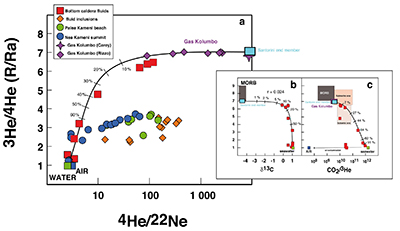 Figure 2 (a) Mixing diagram showing the 3He/4He ratio reported against 4He/22Ne (Ra is the helium atmospheric isotopic ratio). The mantle-derived end member has a 3He/4He ratio of ~ 7 Ra, identical to the value of the nearby Kolumbo volcano (Carey et al., 2013; Rizzo et al., 2016) suggesting a common mantle source. All samples from Palea or Nea Kameni (gases and fluid/melt inclusions in phenocrysts) show a different trend, with a lower 3He/4He ratio reflecting shallow crustal assimilation (Shimizu et al., 2005; Rizzo et al., 2015). The insert shows the 3He/4He ratio versus δ13C (b) and CO2/3He (c). The strong hyperbolic curvature of the mixing curve reported in insert (b) reflects the (4He/CO2)seawater/(4He/CO2)MORB ratio of ~0.024, explaining why the δ13C does not show a mantle value whereas helium almost does. Percentages that are indicated on the mixing curves represent the fraction of seawater-derived helium. | 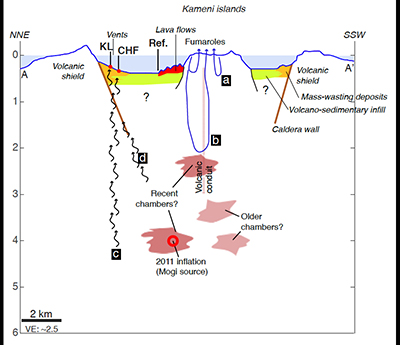 Figure 3 Possible sources and transfer of magmatic CO2 and He within the Santorini caldera. Gases from Nea Kameni derive from a shallow reservoir, which is degassed and has assimilated crustal rocks, sampled by hydrothermal circulation (a, b). A pristine mantle signature is sampled by fluids at the Kalisti Limnes and hydrothermal areas. These fluids may either percolate through the volcanic shield and the pre-volcanic basement (c), or be supplied from a more central area and in association with recent magma chambers, if the fluids migrate along caldera walls and associated caldera faults (d). |
| Figure 1 | Figure 2 | Figure 3 |
top
Introduction
Santorini is one of the most dangerous active volcanoes on Earth, and understanding its dynamics and evolution is fundamental to constrain its degassing history and associated plumbing structure. Santorini is located in the central part of the South Aegean volcanic arc, which extends 500 km from the western Saronikos Gulf up to Nisyros-Kos in the east (Fig. 1). This arc results from the subduction of the remnant ocean crust of the African plate under the Aegean microplate. The last caldera-forming eruption, the famous Minoan eruption 1627 BC (Friedrich et al., 2006
Friedrich, W.L., Kromer, B., Friedrich, M., Heinemeier, J., Pfeiffer, T., Talamo, S. (2006) Santorini Eruption Radiocarbon Dated to 1627-1600 B.C. Science 312, 548.
), was followed by several eruptions building the Palea and Nea Kameni islands within the centre of Santorini caldera (Nomikou et al., 2014Nomikou, P., Parks, M.M., Papanikolaou, D., Pyle, D.M., Mather, T.A., Carey, S., Watts, A.B., Paulatto, M., Kalnins, M.L., Livanos, I., Bejelou, K., Simou, E., Perrose, I. (2014) The emergence and growth of a submarine volcano: The Kameni islands, Santorini (Greece). GeoResJ 1-2, 8-18.
). Since the last volcanic eruption in 1950, a magmatic event with no surface expression occurred between 2011 and 2012. The seismic activity and surface deformation have been attributed to a ~4 km deep magmatic intrusion (Parks et al., 2015Parks, M.M., Moore, J.D.P., Papanikolaou, X., Biggs, J., Mather, T.A., Pyle, D.M., Raptakis, C., Paradissis, D., Hooper, A., Parsons, B., Nomikou, P. (2015) From quiescence to unrest: 20 years of satellite geodetic measurements at Santorini volcano, Greece. Journal of Geophysical Research Solid Earth 120, 1309–1328.
). This subsurface magmatic event is supported by prior studies (Parks et al., 2013Parks, M., Caliro, S., Chiodini, G., Pyle, D.M., Mather, T.A., Berlo, K., Edmonds, M., Biggs, J., Nomikou, P., Raptakis, C. (2013) Distinguishing contributions to diffuse CO2 emissions in volcanic areas from magmatic degassing and thermal decarbonation using soil gas 222Rn–δ13C systematics: Application to Santorini volcano, Greece. Earth and Planetary Science Letters 377-378, 180-190.
; Rizzo et al., 2015Rizzo, A., Barberi, F., Carapezza, L., Di Piazza, A., Francalanci, L., Sortino, F., D'Alessandro, W. (2015) New mafic magma refilling a quiescent volcano: Evidence from He-Ne-Ar isotopes during the 2011–2012 unrest at Santorini, Greece. Geochemistry, Geophysics, Geosystems 16, 798-814.
) that have shown C and He isotopic signals during this unrest period consistent with magmatic intrusion into the shallow plumbing system.Earlier submarine explorations of the caldera seafloor identified several hydrothermal fields at depths of up to ~350 mbsl (Sigurdsson et al., 2006
Sigurdsson, H., Carey, S., Alexandri, M., Vougioukalakis, G., Croff, K., Roman, C., Sakellariou, D., Anagnostou, C., Rousakis, G., Ioakim, C., Godou, A., Ballas, D., Misaridis, T., Nomikou, P. (2006) Marine Investigations of Greece’s Santorini Volcanic Field. EOS 87, 337.
; Nomikou et al., 2013Nomikou, P., Papanikolaou, D., Alexandri, M., Sakellariou , D., Rousakis, G. (2013) Submarine volcanoes along the Aegean volcanic arc. Tectonophysics 597–598, 123-146.
) (Fig. 1). Among the different sites, they observed a vent field in the north of the caldera (Caldera Hydrothermal Field), extending over ~200 x 300 m2, with hundreds of mounds of variable size, ~0.1 to several m in diameter, and raising up to ~2 m above the surrounding sedimented seafloor (Fig. 1). This hydrothermal field aligns with the so-called Kolumbo line, which represents a tectonic structure in the NE favouring the transport of magmas from depths, similar to the Kameni line in the SW of the caldera. The Kolumbo line extends to the NE to the Kolumbo submarine volcano, which is the largest of 25 submarine volcanic cones sited along this fault and is located ~7 km of Santorini (Nomikou et al., 2012Nomikou, P., Carey, S., Papanikolaou, D., Croff Bell, K., Sakellariou, D., Alexandri, M., Bejelou, K. (2012) Submarine volcanoes of the Kolumbo volcanic zone NE of Santorini Caldera, Greece. Global and Planetary Change 90-91, 135-151.
). Trace elements and radiogenic isotopes have shown significant differences suggesting a different petrogenesis and a different mantle source between those two volcanoes (Klaver et al., 2016Klaver, M., Carey, S., Nomikou, P., Smet, I., Godelitsas, A., Vroon, P.Z. (2016) A distinct source and differentiation history for Kolumbo submarine volcano, Santorini volcanic field, Aegean arc. Geochemistry, Geophysics, Geosystems 17, 3254-3273.
), although, based on helium isotopes, Rizzo et al. (2016)Rizzo, A., Caracausi, A., Chavagnac, V., Nomikou, P., Polymenakou, P., Mandalakis, M., Kotoulas, G., Magoulas, A., Castillo, A., Lampridou, D. (2016) Kolumbo submarine volcano (Greece) An active window into the Aegean subduction system. Scientific Reports 6, 1-9.
suggest that the two volcanoes share the same mantle source but a different plumbing.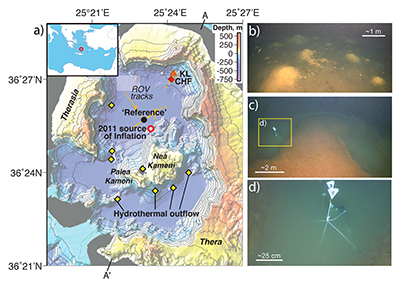
Figure 1 (a) Synthetic topographic map (Nomikou et al., 2014
Nomikou, P., Parks, M.M., Papanikolaou, D., Pyle, D.M., Mather, T.A., Carey, S., Watts, A.B., Paulatto, M., Kalnins, M.L., Livanos, I., Bejelou, K., Simou, E., Perrose, I. (2014) The emergence and growth of a submarine volcano: The Kameni islands, Santorini (Greece). GeoResJ 1-2, 8-18.
) showing the position of hydrothermal outflow areas within the Santorin caldera. Two samples were collected at the ‘Reference’ site, which corresponds to near-bottom water away from hydrothermal sources and at the bottom of the northern basin of the caldera. The other samples were collected at the caldera hydrothermal field (CHF), which shows mounds of bacterial mat (b), and at the Kallisti Limnes (KL), which shows sub-sea pools with CO2-rich fluids (Camilli et al., 2015Camilli, R., Nomikou, P., Escartin, J., Ridao, P., Mallios, A., Kilias, S., Argyraki, A., Andreani, M., Ballu, V., Campos, R., Deplus, C., Gabsi, T., Garcia, R., Gracias, N., Hurtos, N., Magi, L., Mevel, C., Moreira, M., Palomeras, N., Pot, O., Ribas, D., Ruzie, L., Sakellariou, D. (2015) The Kallisti Limnes, carbon dioxide-accumulating subsea pools. Scientific Reports 12152.
) (c and d). CHF and other hydrothermal areas throughout the caldera where observed in 2006 (Sigurdsson et al., 2006Sigurdsson, H., Carey, S., Alexandri, M., Vougioukalakis, G., Croff, K., Roman, C., Sakellariou, D., Anagnostou, C., Rousakis, G., Ioakim, C., Godou, A., Ballas, D., Misaridis, T., Nomikou, P. (2006) Marine Investigations of Greece’s Santorini Volcanic Field. EOS 87, 337.
). The red open circle corresponds to the Mogi source model associated with the 2011 inflation event (Newman et al., 2012Newman, A.V., Stiros, S., Feng, L., Psimoulis, P., Moschas, F., Saltogianni, V., Jiang, Y., Papazachos, C., Panagiotopoulos, D., Karagianni, E., Vamvakaris, D. (2012) Recent geodetic unrest at Santorini Caldera, Greece. Geophysical Research Letters 39, L06309.
). A and A’ indicate the ends of bathymetric profile in Figure 3.The ~350 m deep hydrothermal field along the NE edge of the Santorini caldera was studied in 2012 and immediately after the inflation event observed between 2011 and 2012. The Caldera 2012 cruise deployed the remotely operated vehicle (ROV) Max Rover, the submersible Thetis (both from HCMR, Greece) and the autonomous underwater vehicle (AUV) Girona 500 (U. Girona, Spain). Temperatures within hydrothermal mounds, composed of an accumulation of bacterial fluff, are ~5 °C higher than those of ambient seawater (~15 °C), suggesting low temperature hydrothermal outflow at very low flux rates. During this cruise, we collected water samples above these mounds to constrain their origin using helium, neon and carbon isotopes, and off-site for reference (Fig. 1). Moreover, during this cruise, CO2-rich pools were discovered and sampled slightly north of this hydrothermal field, at the base of the caldera wall and at shallower depths of 250 to 200 m (Camilli et al., 2015
Camilli, R., Nomikou, P., Escartin, J., Ridao, P., Mallios, A., Kilias, S., Argyraki, A., Andreani, M., Ballu, V., Campos, R., Deplus, C., Gabsi, T., Garcia, R., Gracias, N., Hurtos, N., Magi, L., Mevel, C., Moreira, M., Palomeras, N., Pot, O., Ribas, D., Ruzie, L., Sakellariou, D. (2015) The Kallisti Limnes, carbon dioxide-accumulating subsea pools. Scientific Reports 12152.
) (Fig. 1).top
Samples
Fluid samples were acquired with Niskin bottles fitted at the lower part of the ROV and closed by the ROV operators. The ROV also dove into and collected samples within the Kallisti Limnes, and immediately above them. At the caldera floor we recovered samples at ~1 m or less above different hydrothermal mounds. Upon ROV recovery on-board, water samples were transferred from the Niskin bottles to copper tubes sealed with pinch clamps at both ends. He and C isotope measurements were performed at IPGP a few months later.
top
Analytical Procedure and Results
Noble gases were extracted from water samples (standards and samples) using the analytical protocol developed by Greau (2012)
Greau, C. (2012) Apport des gaz rares au suivi hydrogéochimique d’un stockage de CO2 – Application à un analogue naturel de fuites. Thesis University Paris VII.
. Distilled water equilibrated with air is used as standard for He and Ne. Helium and neon were measured using the HELIX-SFT (ThermoFisher©) mass spectrometer sited at IPGP. CO2 concentration and the carbon isotopic ratio were measured at IPGP’s Laboratory of Stable Isotopes using their standard procedure (Assayag et al., 2006Assayag, N., Rivé, K., Ader, M., Jézéquel, D., Agrinier, P. (2006) Improved method for isotopic and quantitative analysis of dissolved inorganic carbon in natural water samples. Rapid Communications in Mass Spectrometry 20, 2243-2251.
).Helium, neon, CO2 abundances, C/3He and isotopic ratios are given in Table S-1. Concentrations of 4He vary between 3.8 x 10-8 and 2.2 x 10-6 cm3 STP/gH2O. The 3He/4He ratio varies between 0.99 ± 0.04 Ra and 6.5 ± 0.3 Ra. The 20Ne/22Ne ratios are atmospheric within uncertainty. The 3He/4He ratio correlates positively with the 4He/22Ne (Fig. 2) suggesting a mixing between air/seawater and a mantle-derived component. The CO2/3He ratio varies from 1.0 x 1010 to 9.25 x 1011. The carbon isotopic ratios vary from -0.13 ± 0.06 up to 1.06 ± 0.06 ‰ relative to the PDB standard and are negatively correlated with the 3He/4He ratios, suggesting also a mixture between two components (Fig. 2).
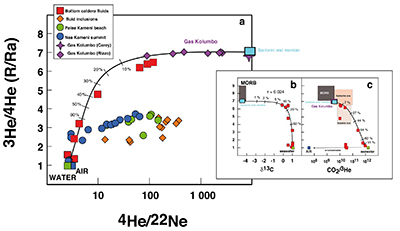
Figure 2 (a) Mixing diagram showing the 3He/4He ratio reported against 4He/22Ne (Ra is the helium atmospheric isotopic ratio). The mantle-derived end member has a 3He/4He ratio of ~ 7 Ra, identical to the value of the nearby Kolumbo volcano (Carey et al., 2013
Carey, S., Nomikou, P., Croff Bell, K., Lilley, M., Lupton, J.E., Roman, C., Stathopoulou, E., Bejelou, K., Ballard, R. (2013) CO2 degassing from hydrothermal vents at Kolumbo submarine volcano, Greece, and the accumulation of acidic crater water. Geology 41, 1035-1038.
; Rizzo et al., 2016Rizzo, A., Caracausi, A., Chavagnac, V., Nomikou, P., Polymenakou, P., Mandalakis, M., Kotoulas, G., Magoulas, A., Castillo, A., Lampridou, D. (2016) Kolumbo submarine volcano (Greece) An active window into the Aegean subduction system. Scientific Reports 6, 1-9.
) suggesting a common mantle source. All samples from Palea or Nea Kameni (gases and fluid/melt inclusions in phenocrysts) show a different trend, with a lower 3He/4He ratio reflecting shallow crustal assimilation (Shimizu et al., 2005Shimizu, A., Sumino, H., Nagao, K., Notsu, K., Mitropoulos, P. (2005) Variation in noble gas isotopic composition of gas samples from the Aegean arc, Greece. Journal of Volcanology and Geothermal Research 140, 321-339.
; Rizzo et al., 2015Rizzo, A., Barberi, F., Carapezza, L., Di Piazza, A., Francalanci, L., Sortino, F., D'Alessandro, W. (2015) New mafic magma refilling a quiescent volcano: Evidence from He-Ne-Ar isotopes during the 2011–2012 unrest at Santorini, Greece. Geochemistry, Geophysics, Geosystems 16, 798-814.
). The insert shows the 3He/4He ratio versus δ13C (b) and CO2/3He (c). The strong hyperbolic curvature of the mixing curve reported in insert (b) reflects the (4He/CO2)seawater/(4He/CO2)MORB ratio of ~0.024, explaining why the δ13C does not show a mantle value whereas helium almost does. Percentages that are indicated on the mixing curves represent the fraction of seawater-derived helium.top
Discussion
The He-C systematics clearly show that fluids have a magmatic origin both for the hydrothermal field with bacterial mounds and for the CO2 pools from the Kallisti Limnes area. Indeed, a measured 3He/4He ratio as high as 6.5 ± 0.3 Ra is typical of volcanic contexts. Moreover, we can correct this measured 3He/4He ratio for the seawater-derived helium using neon, assuming it is entirely of atmospheric origin. The corrected 3He/4He ratio corresponds to the plateau value reached at high 4He/22Ne (>1000) in Figure 2. It is close to ~7 Ra, which is the same ratio measured on CO2-rich gas from Kolumbo submarine volcano (Carey et al., 2013
Carey, S., Nomikou, P., Croff Bell, K., Lilley, M., Lupton, J.E., Roman, C., Stathopoulou, E., Bejelou, K., Ballard, R. (2013) CO2 degassing from hydrothermal vents at Kolumbo submarine volcano, Greece, and the accumulation of acidic crater water. Geology 41, 1035-1038.
; Rizzo et al., 2016Rizzo, A., Caracausi, A., Chavagnac, V., Nomikou, P., Polymenakou, P., Mandalakis, M., Kotoulas, G., Magoulas, A., Castillo, A., Lampridou, D. (2016) Kolumbo submarine volcano (Greece) An active window into the Aegean subduction system. Scientific Reports 6, 1-9.
). Carbon isotopes and the CO2/3He ratios also confirm the mantle origin for the CO2 and helium. The 13C/12C - 3He/4He diagram of Figure 2 suggests a binary mixing between seawater and a mantle-derived component, although the δ13C is not reaching the mantle value of ~-4.5 ‰ (Javoy and Pineau, 1991Javoy, M., Pineau, F. (1991) The volatiles record of a "popping" rock from the Mid-Atlantic Ridge at 14°N: chemical and isotopic composition of gas trapped in the vesicles. Earth and Planetary Science Letters 107, 598-611.
).The helium isotopic ratios measured in our studied samples are less radiogenic than fluids or minerals collected on the active zone of Palea and Nea Kameni islands (Shimizu et al., 2005
Shimizu, A., Sumino, H., Nagao, K., Notsu, K., Mitropoulos, P. (2005) Variation in noble gas isotopic composition of gas samples from the Aegean arc, Greece. Journal of Volcanology and Geothermal Research 140, 321-339.
; Rizzo et al., 2015Rizzo, A., Barberi, F., Carapezza, L., Di Piazza, A., Francalanci, L., Sortino, F., D'Alessandro, W. (2015) New mafic magma refilling a quiescent volcano: Evidence from He-Ne-Ar isotopes during the 2011–2012 unrest at Santorini, Greece. Geochemistry, Geophysics, Geosystems 16, 798-814.
). The shallow magma chamber beneath the volcanic active centre of Santorini, is probably located at ~3-4 km depth (Fig. 3) (Parks et al., 2015Parks, M.M., Moore, J.D.P., Papanikolaou, X., Biggs, J., Mather, T.A., Pyle, D.M., Raptakis, C., Paradissis, D., Hooper, A., Parsons, B., Nomikou, P. (2015) From quiescence to unrest: 20 years of satellite geodetic measurements at Santorini volcano, Greece. Journal of Geophysical Research Solid Earth 120, 1309–1328.
). The helium isotopic signature of the surface fumaroles or bubbling springs at the islands does not reach the mantle isotopic signature observed in deep hydrothermal field and CO2 pools of the northeast flank of the caldera (Fig. 2). Therefore, the more radiogenic helium isotopic ratios measured on the fumaroles or bubbling springs from Nea Kameni cannot be considered as reflecting the mantle source and the possible presence of recycled sediments in it, revealing instead rather shallow processes of contamination, as also suggested by Rizzo et al. (2016)Rizzo, A., Caracausi, A., Chavagnac, V., Nomikou, P., Polymenakou, P., Mandalakis, M., Kotoulas, G., Magoulas, A., Castillo, A., Lampridou, D. (2016) Kolumbo submarine volcano (Greece) An active window into the Aegean subduction system. Scientific Reports 6, 1-9.
. The value of the helium isotopic ratio of both Santorini and Kolumbo volcanoes (~7 Ra) suggests that the source of volatiles is the asthenosphere rather than the subcontinental lithospheric mantle, which presents a more radiogenic helium isotopic ratio of 6.1 ± 0.9 than the MORB source (Gautheron and Moreira, 2002Gautheron, C., Moreira, M. (2002) Helium signature of the subcontinental lithospheric mantle. Earth and Planetary Science Letters 199, 39-47.
).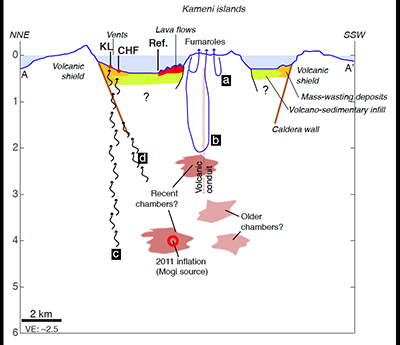
Figure 3 Possible sources and transfer of magmatic CO2 and He within the Santorini caldera. Gases from Nea Kameni derive from a shallow reservoir, which is degassed and has assimilated crustal rocks, sampled by hydrothermal circulation (a, b). A pristine mantle signature is sampled by fluids at the Kalisti Limnes and hydrothermal areas. These fluids may either percolate through the volcanic shield and the pre-volcanic basement (c), or be supplied from a more central area and in association with recent magma chambers, if the fluids migrate along caldera walls and associated caldera faults (d).
Although the deep magmatic origin for helium and CO2 in the northeast hydrothermal field is clear, the flux of magmatic gases is low. At Santorini, there is no observed bubbling in this hydrothermal field, while bubbling is abundant and widespread within the nearby Kolumbo submarine volcano, at the north of the crater (Nomikou et al., 2012
Nomikou, P., Carey, S., Papanikolaou, D., Croff Bell, K., Sakellariou, D., Alexandri, M., Bejelou, K. (2012) Submarine volcanoes of the Kolumbo volcanic zone NE of Santorini Caldera, Greece. Global and Planetary Change 90-91, 135-151.
; Carey et al., 2013Carey, S., Nomikou, P., Croff Bell, K., Lilley, M., Lupton, J.E., Roman, C., Stathopoulou, E., Bejelou, K., Ballard, R. (2013) CO2 degassing from hydrothermal vents at Kolumbo submarine volcano, Greece, and the accumulation of acidic crater water. Geology 41, 1035-1038.
; Rizzo et al., 2016Rizzo, A., Caracausi, A., Chavagnac, V., Nomikou, P., Polymenakou, P., Mandalakis, M., Kotoulas, G., Magoulas, A., Castillo, A., Lampridou, D. (2016) Kolumbo submarine volcano (Greece) An active window into the Aegean subduction system. Scientific Reports 6, 1-9.
). The Santorini hydrothermal mounds also show temperatures that are only 5 °C above ambient seawater temperature, much lower than the >100 °C measured at Kolumbo’s hydrothermal outflows. These temperatures and the visual observations of the mounds and CO2 pools, with no visual evidence of flow, indicate that the hydrothermal flux at the Caldera Field is very low. A dilution of the gas flux from the mantle is required before reaching surface. Anomalies of He and CO2 concentrations were measured on soils onshore along the Kolumbo line (Barberi and Carapezza, 1994Barberi, F., Carapezza, L. (1994) Helium and CO2 soil gas emission from Santorini (Greece). Bulletin of Volcanology 56, 335-342.
). Unfortunately, no isotopic composition was measured to confirm if these gases are the same. However, the location of these anomalous concentrations of He and CO2 suggests that the mantle-derived gases we observed at the bottom of Santorini caldera extend up to the surface, following the tectonic Kolumbo line, which we therefore infer to be preferential path for degassing.Figure 3 summarises our vision of the different degassing processes occurring within Santorini caldera. Magmatic gases from the shallow magmatic chamber degas below Nea and Palea Kameni thanks to hydrothermal circulation, although their compositions do not reflect the mantle source. Crustal assimilation has altered these deep-seated signatures and, notwithstanding recent magma injections, the helium isotopic composition is not representative of the mantle source. A flux of magmatic CO2 and helium is observed on the NE of the caldera, on the Kalisti Limnes and on caldera hydrothermal areas, with mantle compositions. However, the gas likely focuses along the tectonic Kolumbo line, with a very weak flux and diluted with seawater. A detailed work on the geometry, extent, and thermal structure of these vents is required to estimate this magmatic gas flux better. The helium isotopic signature is similar to the one of the Kolumbo volcano (Carey et al., 2013
Carey, S., Nomikou, P., Croff Bell, K., Lilley, M., Lupton, J.E., Roman, C., Stathopoulou, E., Bejelou, K., Ballard, R. (2013) CO2<:sub> degassing from hydrothermal vents at Kolumbo submarine volcano, Greece, and the accumulation of acidic crater water. Geology 41, 1035-1038.
; Rizzo et al., 2016Rizzo, A., Caracausi, A., Chavagnac, V., Nomikou, P., Polymenakou, P., Mandalakis, M., Kotoulas, G., Magoulas, A., Castillo, A., Lampridou, D. (2016) Kolumbo submarine volcano (Greece) An active window into the Aegean subduction system. Scientific Reports 6, 1-9.
), suggesting that those two volcanoes either sample the same magmatic source for volatiles, or there are two different sources that are geochemically similar for volatiles, although they might be different for other elements (Klaver et al., 2016Klaver, M., Carey, S., Nomikou, P., Smet, I., Godelitsas, A., Vroon, P.Z. (2016) A distinct source and differentiation history for Kolumbo submarine volcano, Santorini volcanic field, Aegean arc. Geochemistry, Geophysics, Geosystems 17, 3254-3273.
). Moreover, this source appears similar to the MORB source instead of being the subcontinental mantle, which presents a more radiogenic helium isotopic signature (Gautheron and Moreira, 2002Gautheron, C., Moreira, M. (2002) Helium signature of the subcontinental lithospheric mantle. Earth and Planetary Science Letters 199, 39-47.
).top
Conclusions
Using new helium and CO2 in water collected at the bottom of the Santorini caldera, at recently discovered hydrothermal fields and nearby CO2-rich pools (Kallisti Limnes), we show that C and He at Santorini are mantle-derived and that the magma source of these volatiles is similar to that of the nearby Kolumbo submarine volcano. The fluids from the submarine hydrothermal field derive directly from the deep magmatic system of Santorini without being affected by the shallow magmatic plumbing as for Nea and Palea Kameni islands. These fluids follow efficient paths to the seafloor likely along fault zones anchored deep in the volcanic arc. The helium isotopic composition show that the mantle source of the Santorini magmatism is more likely the asthenosphere than the subcontinental lithospheric mantle.
top
Acknowledgements
We thank the crew of the R/V AEGEO and the pilots of the ROV Max Rover. C. Chaduteau is thanked for the carbon analyses. Ship time was provided by the Eurofleets CALDERA 2012 Project (EU) and by HCMR (Greece). JE and CM were also partly supported by the DCO initiative from the Alfred Sloan Foundation. MM thanks the region Ile de France (SESAME) for the funding of the Helix-SFT. This is IPGP contribution number 4040.
Editors: Helen Williams, Maud Boyet
top
References
Assayag, N., Rivé, K., Ader, M., Jézéquel, D., Agrinier, P. (2006) Improved method for isotopic and quantitative analysis of dissolved inorganic carbon in natural water samples. Rapid Communications in Mass Spectrometry 20, 2243-2251.
 Show in context
Show in context CO2 concentration and the carbon isotopic ratio were measured at IPGP’s Laboratory of Stable Isotopes using their standard procedure (Assayag et al., 2006).
View in article
Barberi, F., Carapezza, L. (1994) Helium and CO2 soil gas emission from Santorini (Greece). Bulletin of Volcanology 56, 335-342.
 Show in context
Show in contextAnomalies of He and CO2 concentrations were measured on soils onshore along the Kolumbo line (Barberi and Carapezza, 1994).
View in article
Camilli, R., Nomikou, P., Escartin, J., Ridao, P., Mallios, A., Kilias, S., Argyraki, A., Andreani, M., Ballu, V., Campos, R., Deplus, C., Gabsi, T., Garcia, R., Gracias, N., Hurtos, N., Magi, L., Mevel, C., Moreira, M., Palomeras, N., Pot, O., Ribas, D., Ruzie, L., Sakellariou, D. (2015) The Kallisti Limnes, carbon dioxide-accumulating subsea pools. Scientific Reports 12152.
 Show in context
Show in contextFigugre 1 [...] The other samples were collected at the caldera hydrothermal field (CHF), which shows mounds of bacterial mat (b), and at the Kallisti Limnes (KL), which shows sub-sea pools with CO2-rich fluids (Camilli et al., 2015) (c and d).
View in article
Moreover, during this cruise, CO2-rich pools were discovered and sampled slightly north of this hydrothermal field, at the base of the caldera wall and at shallower depths of 250 to 200 m (Camilli et al., 2015) (Fig. 1).
View in article
Carey, S., Nomikou, P., Croff Bell, K., Lilley, M., Lupton, J.E., Roman, C., Stathopoulou, E., Bejelou, K., Ballard, R. (2013) CO2 degassing from hydrothermal vents at Kolumbo submarine volcano, Greece, and the accumulation of acidic crater water. Geology 41, 1035-1038.
 Show in context
Show in context Figure 2 [...] The mantle-derived end member has a 3He/4He ratio of ~ 7 Ra, identical to the value of the nearby Kolumbo volcano (Carey et al., 2013; Rizzo et al., 2016) suggesting a common mantle source.
View in article
It is close to ~7 Ra, which is the same ratio measured on CO2-rich gas from Kolumbo submarine volcano (Carey et al., 2013; Rizzo et al., 2016).
View in article
At Santorini, there is no observed bubbling in this hydrothermal field, while bubbling is abundant and widespread within the nearby Kolumbo submarine volcano, at the north of the crater (Nomikou et al., 2012; Carey et al., 2013; Rizzo et al., 2016).
View in article
The helium isotopic signature is similar to the one of the Kolumbo volcano (Carey et al., 2013; Rizzo et al., 2016), suggesting that those two volcanoes either sample the same magmatic source for volatiles, or there are two different sources that are geochemically similar for volatiles, although they might be different for other elements (Klaver et al., 2016).
View in article
Friedrich, W.L., Kromer, B., Friedrich, M., Heinemeier, J., Pfeiffer, T., Talamo, S. (2006) Santorini Eruption Radiocarbon Dated to 1627-1600 B.C. Science 312, 548.
 Show in context
Show in contextThe last caldera-forming eruption, the famous Minoan eruption 1627 BC (Friedrich et al., 2006), was followed by several eruptions building the Palea and Nea Kameni islands within the centre of Santorini caldera (Nomikou et al., 2014).
View in article
Gautheron, C., Moreira, M. (2002) Helium signature of the subcontinental lithospheric mantle. Earth and Planetary Science Letters 199, 39-47.
 Show in context
Show in context The value of the helium isotopic ratio of both Santorini and Kolumbo volcanoes (~7 Ra) suggests that the source of volatiles is the asthenosphere rather than the subcontinental lithospheric mantle, which presents a more radiogenic helium isotopic ratio of 6.1 ± 0.9 than the MORB source (Gautheron and Moreira, 2002).
View in article
Moreover, this source appears similar to the MORB source instead of being the subcontinental mantle, which presents a more radiogenic helium isotopic signature (Gautheron and Moreira, 2002).
View in article
Greau, C. (2012) Apport des gaz rares au suivi hydrogéochimique d’un stockage de CO2 – Application à un analogue naturel de fuites. Thesis University Paris VII.
 Show in context
Show in context Noble gases were extracted from water samples (standards and samples) using the analytical protocol developed by Greau (2012).
View in article
Javoy, M., Pineau, F. (1991) The volatiles record of a "popping" rock from the Mid-Atlantic Ridge at 14°N: chemical and isotopic composition of gas trapped in the vesicles. Earth and Planetary Science Letters 107, 598-611.
 Show in context
Show in context The 13C/12C - 3He/4He diagram of Figure 2 suggests a binary mixing between seawater and a mantle-derived component, although the δ13C is not reaching the mantle value of ~-4.5 ‰ (Javoy and Pineau, 1991).
View in article
Klaver, M., Carey, S., Nomikou, P., Smet, I., Godelitsas, A., Vroon, P.Z. (2016) A distinct source and differentiation history for Kolumbo submarine volcano, Santorini volcanic field, Aegean arc. Geochemistry, Geophysics, Geosystems 17, 3254-3273.
 Show in context
Show in context Trace elements and radiogenic isotopes have shown significant differences suggesting a different petrogenesis and a different mantle source between those two volcanoes (Klaver et al., 2016), although, based on helium isotopes, Rizzo et al. (2016) suggest that the two volcanoes share the same mantle source but a different plumbing.
View in article
The helium isotopic signature is similar to the one of the Kolumbo volcano (Carey et al., 2013; Rizzo et al., 2016), suggesting that those two volcanoes either sample the same magmatic source for volatiles, or there are two different sources that are geochemically similar for volatiles, although they might be different for other elements (Klaver et al., 2016).
View in article
Newman, A.V., Stiros, S., Feng, L., Psimoulis, P., Moschas, F., Saltogianni, V., Jiang, Y., Papazachos, C., Panagiotopoulos, D., Karagianni, E., Vamvakaris, D. (2012) Recent geodetic unrest at Santorini Caldera, Greece. Geophysical Research Letters 39, L06309.
 Show in context
Show in context Figure 1 [...] The red open circle corresponds to the Mogi source model associated with the 2011 inflation event (Newman et al., 2012).
View in article
Nomikou, P., Carey, S., Papanikolaou, D., Croff Bell, K., Sakellariou, D., Alexandri, M., Bejelou, K. (2012) Submarine volcanoes of the Kolumbo volcanic zone NE of Santorini Caldera, Greece. Global and Planetary Change 90-91, 135-151.
 Show in context
Show in context The Kolumbo line extends to the NE to the Kolumbo submarine volcano, which is the largest of 25 submarine volcanic cones sited along this fault and is located ~7 km of Santorini (Nomikou et al., 2012).
View in article
At Santorini, there is no observed bubbling in this hydrothermal field, while bubbling is abundant and widespread within the nearby Kolumbo submarine volcano, at the north of the crater (Nomikou et al., 2012; Carey et al., 2013; Rizzo et al., 2016).
View in article
Nomikou, P., Papanikolaou, D., Alexandri, M., Sakellariou , D., Rousakis, G. (2013) Submarine volcanoes along the Aegean volcanic arc. Tectonophysics 597–598, 123-146.
 Show in context
Show in context Earlier submarine explorations of the caldera seafloor identified several hydrothermal fields at depths of up to ~350 mbsl (Sigurdsson et al., 2006; Nomikou et al., 2013) (Fig. 1).
View in article
Nomikou, P., Parks, M.M., Papanikolaou, D., Pyle, D.M., Mather, T.A., Carey, S., Watts, A.B., Paulatto, M., Kalnins, M.L., Livanos, I., Bejelou, K., Simou, E., Perrose, I. (2014) The emergence and growth of a submarine volcano: The Kameni islands, Santorini (Greece). GeoResJ 1-2, 8-18.
 Show in context
Show in context The last caldera-forming eruption, the famous Minoan eruption 1627 BC (Friedrich et al., 2006), was followed by several eruptions building the Palea and Nea Kameni islands within the centre of Santorini caldera (Nomikou et al., 2014).
View in article
Figure 1 (a) Synthetic topographic map (Nomikou et al., 2014) showing the position of hydrothermal outflow areas within the Santorin caldera.
View in article
Parks, M., Caliro, S., Chiodini, G., Pyle, D.M., Mather, T.A., Berlo, K., Edmonds, M., Biggs, J., Nomikou, P., Raptakis, C. (2013) Distinguishing contributions to diffuse CO2 emissions in volcanic areas from magmatic degassing and thermal decarbonation using soil gas 222Rn–δ13C systematics: Application to Santorini volcano, Greece. Earth and Planetary Science Letters 377-378, 180-190.
 Show in context
Show in contextThis subsurface magmatic event is supported by prior studies (Parks et al., 2013; Rizzo et al., 2015) that have shown C and He isotopic signals during this unrest period consistent with magmatic intrusion into the shallow plumbing system.
View in article
Parks, M.M., Moore, J.D.P., Papanikolaou, X., Biggs, J., Mather, T.A., Pyle, D.M., Raptakis, C., Paradissis, D., Hooper, A., Parsons, B., Nomikou, P. (2015) From quiescence to unrest: 20 years of satellite geodetic measurements at Santorini volcano, Greece. Journal of Geophysical Research Solid Earth 120, 1309–1328.
 Show in context
Show in contextThe seismic activity and surface deformation have been attributed to a ~4 km deep magmatic intrusion (Parks et al., 2015).
View in article
The shallow magma chamber beneath the volcanic active centre of Santorini, is probably located at ~3-4 km depth (Fig. 3) (Parks et al., 2015).
View in article
Rizzo, A., Barberi, F., Carapezza, L., Di Piazza, A., Francalanci, L., Sortino, F., D'Alessandro, W. (2015) New mafic magma refilling a quiescent volcano: Evidence from He-Ne-Ar isotopes during the 2011–2012 unrest at Santorini, Greece. Geochemistry, Geophysics, Geosystems 16, 798-814.
 Show in context
Show in context This subsurface magmatic event is supported by prior studies (Parks et al., 2013; Rizzo et al., 2015) that have shown C and He isotopic signals during this unrest period consistent with magmatic intrusion into the shallow plumbing system.
View in article
Figure 2 [...] All samples from Palea or Nea Kameni (gases and fluid/melt inclusions in phenocrysts) show a different trend, with a lower 3He/4He ratio reflecting shallow crustal assimilation (Shimizu et al., 2005; Rizzo et al., 2015).
View in article
The helium isotopic ratios measured in our studied samples are less radiogenic than fluids or minerals collected on the active zone of Palea and Nea Kameni islands (Shimizu et al., 2005; Rizzo et al., 2015).
View in article
Rizzo, A., Caracausi, A., Chavagnac, V., Nomikou, P., Polymenakou, P., Mandalakis, M., Kotoulas, G., Magoulas, A., Castillo, A., Lampridou, D. (2016) Kolumbo submarine volcano (Greece) An active window into the Aegean subduction system. Scientific Reports 6, 1-9.
 Show in context
Show in context Trace elements and radiogenic isotopes have shown significant differences suggesting a different petrogenesis and a different mantle source between those two volcanoes (Klaver et al., 2016), although, based on helium isotopes, Rizzo et al. (2016) suggest that the two volcanoes share the same mantle source but a different plumbing.
View in article
Figure 2 [...] The mantle-derived end member has a 3He/4He ratio of ~ 7 Ra, identical to the value of the nearby Kolumbo volcano (Carey et al., 2013; Rizzo et al., 2016) suggesting a common mantle source.
View in article
It is close to ~7 Ra, which is the same ratio measured on CO2-rich gas from Kolumbo submarine volcano (Carey et al., 2013; Rizzo et al., 2016).
View in article
Therefore, the more radiogenic helium isotopic ratios measured on the fumaroles or bubbling springs from Nea Kameni cannot be considered as reflecting the mantle source and the possible presence of recycled sediments in it, revealing instead rather shallow processes of contamination, as also suggested by Rizzo et al. (2016).
View in article
At Santorini, there is no observed bubbling in this hydrothermal field, while bubbling is abundant and widespread within the nearby Kolumbo submarine volcano, at the north of the crater (Nomikou et al., 2012; Carey et al., 2013; Rizzo et al., 2016).
View in article
The helium isotopic signature is similar to the one of the Kolumbo volcano (Carey et al., 2013; Rizzo et al., 2016), suggesting that those two volcanoes either sample the same magmatic source for volatiles, or there are two different sources that are geochemically similar for volatiles, although they might be different for other elements (Klaver et al., 2016).
View in article
Shimizu, A., Sumino, H., Nagao, K., Notsu, K., Mitropoulos, P. (2005) Variation in noble gas isotopic composition of gas samples from the Aegean arc, Greece. Journal of Volcanology and Geothermal Research 140, 321-339.
 Show in context
Show in context Figure 2 [...] All samples from Palea or Nea Kameni (gases and fluid/melt inclusions in phenocrysts) show a different trend, with a lower 3He/4He ratio reflecting shallow crustal assimilation (Shimizu et al., 2005; Rizzo et al., 2015).
View in article
The helium isotopic ratios measured in our studied samples are less radiogenic than fluids or minerals collected on the active zone of Palea and Nea Kameni islands (Shimizu et al., 2005; Rizzo et al., 2015).
View in article
Sigurdsson, H., Carey, S., Alexandri, M., Vougioukalakis, G., Croff, K., Roman, C., Sakellariou, D., Anagnostou, C., Rousakis, G., Ioakim, C., Godou, A., Ballas, D., Misaridis, T., Nomikou, P. (2006) Marine Investigations of Greece’s Santorini Volcanic Field. EOS 87, 337.
 Show in context
Show in contextEarlier submarine explorations of the caldera seafloor identified several hydrothermal fields at depths of up to ~350 mbsl (Sigurdsson et al., 2006; Nomikou et al., 2013) (Fig. 1).
View in article
Figure 1 [...] CHF and other hydrothermal areas throughout the caldera where observed in 2006 (Sigurdsson et al., 2006).
View in article
top
Supplementary Information
The Supplementary Information includes:
- Table S-1
Download the Supplementary Information (PDF)
Figures and Tables

Figure 1 (a) Synthetic topographic map (Nomikou et al., 2014
Nomikou, P., Parks, M.M., Papanikolaou, D., Pyle, D.M., Mather, T.A., Carey, S., Watts, A.B., Paulatto, M., Kalnins, M.L., Livanos, I., Bejelou, K., Simou, E., Perrose, I. (2014) The emergence and growth of a submarine volcano: The Kameni islands, Santorini (Greece). GeoResJ 1-2, 8-18.
) showing the position of hydrothermal outflow areas within the Santorin caldera. Two samples were collected at the ‘Reference’ site, which corresponds to near-bottom water away from hydrothermal sources and at the bottom of the northern basin of the caldera. The other samples were collected at the caldera hydrothermal field (CHF), which shows mounds of bacterial mat (b), and at the Kallisti Limnes (KL), which shows sub-sea pools with CO2-rich fluids (Camilli et al., 2015Camilli, R., Nomikou, P., Escartin, J., Ridao, P., Mallios, A., Kilias, S., Argyraki, A., Andreani, M., Ballu, V., Campos, R., Deplus, C., Gabsi, T., Garcia, R., Gracias, N., Hurtos, N., Magi, L., Mevel, C., Moreira, M., Palomeras, N., Pot, O., Ribas, D., Ruzie, L., Sakellariou, D. (2015) The Kallisti Limnes, carbon dioxide-accumulating subsea pools. Scientific Reports 12152.
) (c and d). CHF and other hydrothermal areas throughout the caldera where observed in 2006 (Sigurdsson et al., 2006Sigurdsson, H., Carey, S., Alexandri, M., Vougioukalakis, G., Croff, K., Roman, C., Sakellariou, D., Anagnostou, C., Rousakis, G., Ioakim, C., Godou, A., Ballas, D., Misaridis, T., Nomikou, P. (2006) Marine Investigations of Greece’s Santorini Volcanic Field. EOS 87, 337.
). The red open circle corresponds to the Mogi source model associated with the 2011 inflation event (Newman et al., 2012Newman, A.V., Stiros, S., Feng, L., Psimoulis, P., Moschas, F., Saltogianni, V., Jiang, Y., Papazachos, C., Panagiotopoulos, D., Karagianni, E., Vamvakaris, D. (2012) Recent geodetic unrest at Santorini Caldera, Greece. Geophysical Research Letters 39, L06309.
). A and A’ indicate the ends of bathymetric profile in Figure 3.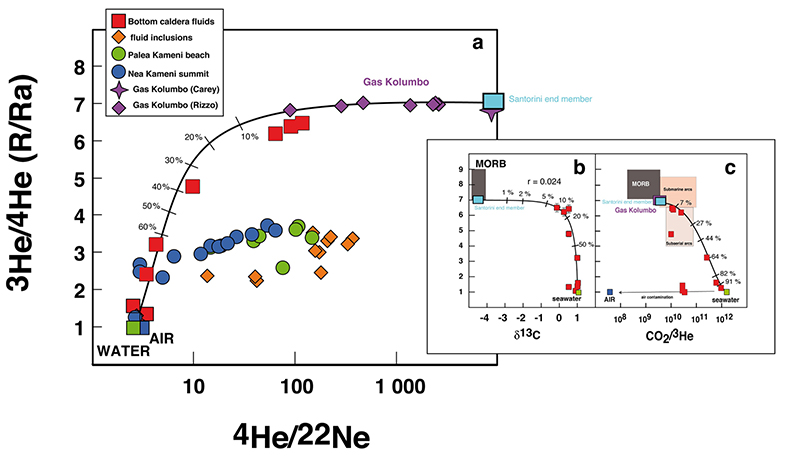
Figure 2 (a) Mixing diagram showing the 3He/4He ratio reported against 4He/22Ne (Ra is the helium atmospheric isotopic ratio). The mantle-derived end member has a 3He/4He ratio of ~ 7 Ra, identical to the value of the nearby Kolumbo volcano (Carey et al., 2013
Carey, S., Nomikou, P., Croff Bell, K., Lilley, M., Lupton, J.E., Roman, C., Stathopoulou, E., Bejelou, K., Ballard, R. (2013) CO2 degassing from hydrothermal vents at Kolumbo submarine volcano, Greece, and the accumulation of acidic crater water. Geology 41, 1035-1038.
; Rizzo et al., 2016Rizzo, A., Caracausi, A., Chavagnac, V., Nomikou, P., Polymenakou, P., Mandalakis, M., Kotoulas, G., Magoulas, A., Castillo, A., Lampridou, D. (2016) Kolumbo submarine volcano (Greece) An active window into the Aegean subduction system. Scientific Reports 6, 1-9.
) suggesting a common mantle source. All samples from Palea or Nea Kameni (gases and fluid/melt inclusions in phenocrysts) show a different trend, with a lower 3He/4He ratio reflecting shallow crustal assimilation (Shimizu et al., 2005Shimizu, A., Sumino, H., Nagao, K., Notsu, K., Mitropoulos, P. (2005) Variation in noble gas isotopic composition of gas samples from the Aegean arc, Greece. Journal of Volcanology and Geothermal Research 140, 321-339.
; Rizzo et al., 2015Rizzo, A., Barberi, F., Carapezza, L., Di Piazza, A., Francalanci, L., Sortino, F., D'Alessandro, W. (2015) New mafic magma refilling a quiescent volcano: Evidence from He-Ne-Ar isotopes during the 2011–2012 unrest at Santorini, Greece. Geochemistry, Geophysics, Geosystems 16, 798-814.
). The insert shows the 3He/4He ratio versus δ13C (b) and CO2/3He (c). The strong hyperbolic curvature of the mixing curve reported in insert (b) reflects the (4He/CO2)seawater/(4He/CO2)MORB ratio of ~0.024, explaining why the δ13C does not show a mantle value whereas helium almost does. Percentages that are indicated on the mixing curves represent the fraction of seawater-derived helium.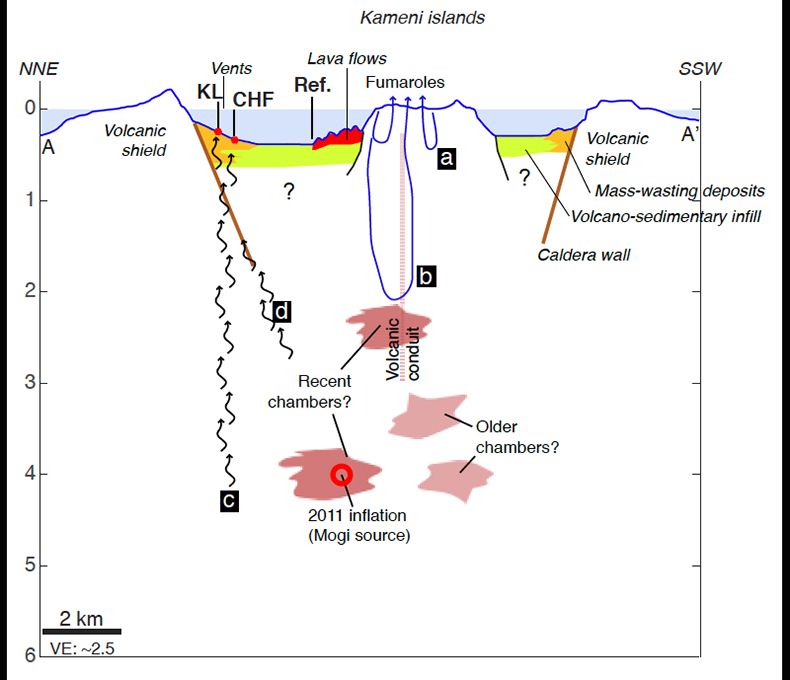
Figure 3 Possible sources and transfer of magmatic CO2 and He within the Santorini caldera. Gases from Nea Kameni derive from a shallow reservoir, which is degassed and has assimilated crustal rocks, sampled by hydrothermal circulation (a, b). A pristine mantle signature is sampled by fluids at the Kalisti Limnes and hydrothermal areas. These fluids may either percolate through the volcanic shield and the pre-volcanic basement (c), or be supplied from a more central area and in association with recent magma chambers, if the fluids migrate along caldera walls and associated caldera faults (d).






